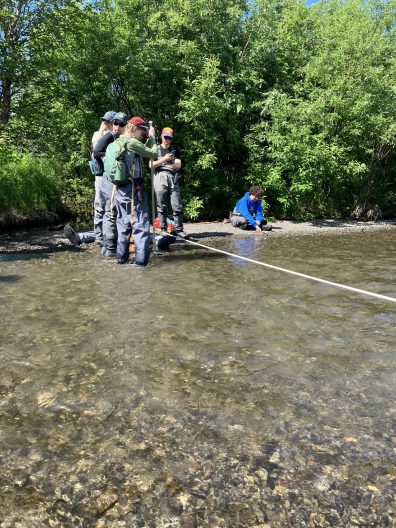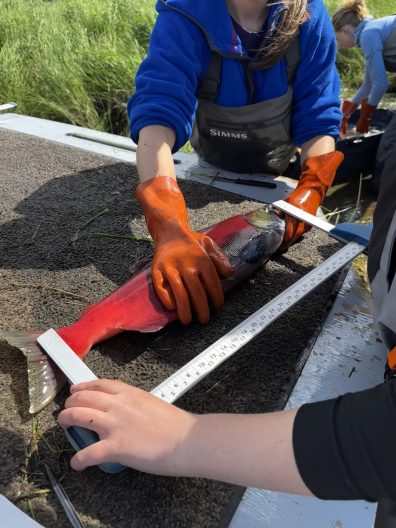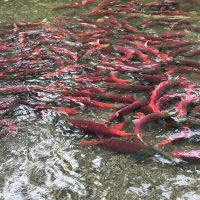The return of the sockeye: a summer with the Alaska Salmon Program
It’s all in the name: the Alaska Salmon Program. Each year, students from the University of Washington head up to southwest Alaska, part of a 75-year-old program dedicated to all aspects of the ecology and evolution of Pacific salmon in the watersheds of western Alaska, the Bering Sea, and the Gulf of Alaska.

You may be familiar with the Alaska Salmon Program (ASP) and its critical role in producing data and knowledge for managing and conserving regional ecosystems and their fisheries. But we’re doing a deeper dive into the role of students in the program, focusing on the opportunities for immersive learning and discovery they have when at the field camps, and the bonding experience with both fellow students and instructors during their time in Alaska.
In the 2024 summer field season, eight students headed up to the ASP camps based in the Wood River system. Nestled among Lake Aleknagik and Lake Nerka – which are two of five interconnected lakes which drain via the Wood River into the Nushagak River – are the camps students call home for a month or so, living and breathing fishery science.
Emma Bell, a community college transfer student who is about to graduate with a bachelor’s in Aquatic and Fishery Sciences from SAFS, remarked that the view from the dining area was unbeatable. “Sitting in the main house and looking out the sliding glass door every day was one of my favorite parts. Being able to unplug a bit from the real world and just sit with the beauty of Alaska was something I really needed.”

Undergraduates visit Alaska as part of the AERA class (Aquatic Ecological Research in Alaska), supported by graduate students, field technicians, staff and professors. And a unique part of the class is that it goes hand-in-hand with fieldwork, where students can put into practice the knowledge, concepts, and skills they learn. For Ryan Luvera, a SAFS and Marine Biology double major about to enter his third year at UW, connecting key concepts and real-world applications was vital: “Learning so much about Bristol Bay and the ecosystem at large was a highlight for me. I feel like my view of nature has changed completely with all the knowledge I’ve gained, largely from the professors in the AERA class, and knowledge that you gain from being able to experience the scenery firsthand.”

So what does a day in the life of a student with the Alaska Salmon Program look like? “Days varied, but generally we were up and ready to go at 9am,” said Emma Meyer, a junior at SAFS. “We would go to the classroom for a few hours of lectures before heading out to the field. Fieldwork could range from measuring sediment size to sampling juvenile salmon to collecting otoliths. In the afternoon, we caught up with assignments before dinner, then have some downtime.”
By the start of July, millions of sockeye salmon return to the lakes and rivers where ASP students are studying. “The field was incredible, and it was amazing to be out there seeing all the salmon day in and day out,” shared Emma Bell. “We talk a lot about salmon in Washington and in our classes at SAFS but actually standing in a stream where thousands of sockeye are spawning really puts things in perspective for you.”

Building up skills that will set students in good stead for future studies and careers involving fishery science and fieldwork is a vital goal of the Alaska Salmon Program. “There was no better way to learn than to be out in the field with your professors,” shared Callie Murakami, an Aquatic and Fishery Sciences major going into junior year. “It was one thing to be taught in the classroom by all the amazing researchers but being outside with them and asking questions about the salmon, streams, and surrounding environment while we were right there in it was so much more memorable and a lot more hands-on. I loved when we were out in the field collecting data and chatting.”
Spending so much time in the field also provides a unique chance for students to build confidence in themselves. “What I didn’t expect was how much my confidence in myself increased,” said Emma Meyer. “As a transfer student, I had some moments of imposter syndrome during my first year at UW, where I felt behind in my scientific and academic background, but I found that I was more than capable. I learned how to collaborate with my peers, and the program helped me to see that we’re not competing and that there’s a place for everyone as long as we’re willing to learn from each other.”
But it’s not all work! Stay tuned for our next blog where we hear from students about their downtime in Alaska, what community living in a field camp involves, and how students found out about the opportunity to spend a month in Alaska.
